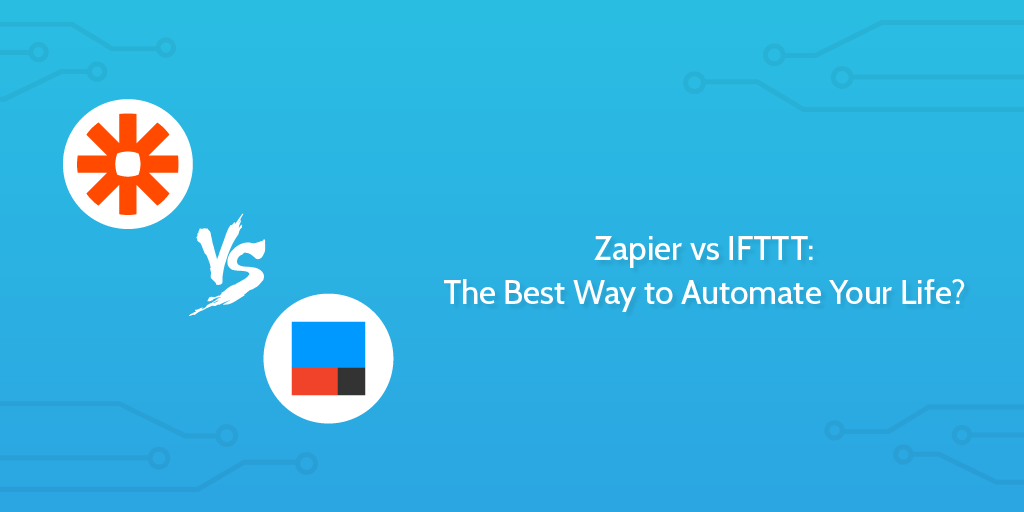
[ Download our Free Ebook ] – Click here to download our free 111 page ebook on “How to automate the tasks you hate at work using Zapier“.
Business vs Casual, Zapier vs IFTTT
Whether it’s Coke vs Pepsi, Ariel vs Persil or Hawaiian pizza vs everything good in the world, rivalries are everywhere. They make for fantastic spectator sports and can help improve our lives by showing the flaws in each side.
In our efforts to help you guys automate as much of the laborious shovel work in your lives as possible, we came across two main competitors; the great battle that is Zapier vs IFTTT.

Okay, so maybe “battle” is over-dramatizing things a little; it’s not as if they’re running massive smear campaigns. Still, the competition is real, as both Zapier and IFTTT have earned their spots on the map for being darned good pieces of kit. This got us thinking; which is better?
Here at Process Street, we’re not usually ones to stir up the hornet’s nest and pit one thing against another. Unless it’s the company Hearthstone tournament, in which case all bets are off.
In this case, however, we made an exception and took a long hard look at both Zapier and IFTTT; both are cause and effect automation software, but which should you be using to give yourself that extra bit of free time?
The Basics
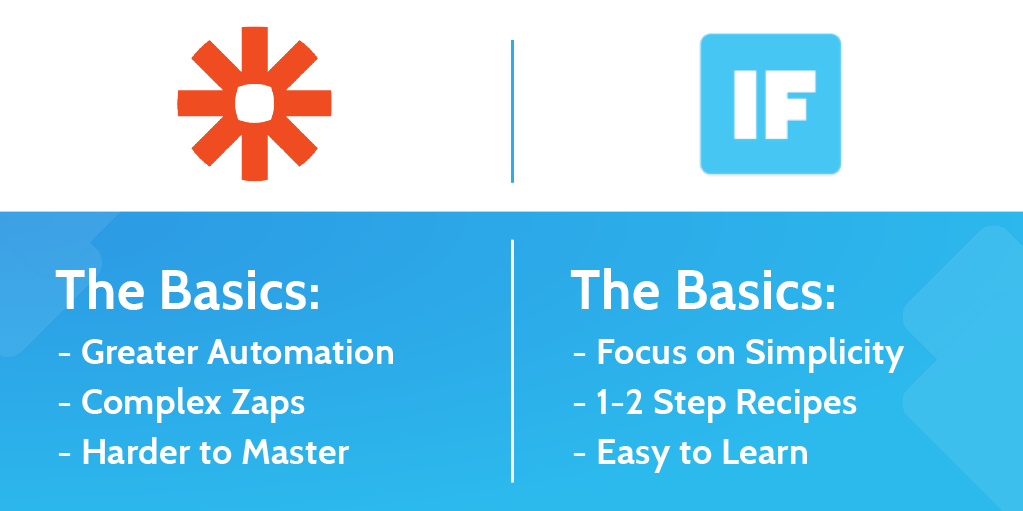
Let’s start things off with a look at the basics; we already know what Zapier is and what it can do. Zapier runs on a cause and effect model, although you are by no means limited to a single effect, and you are able to filter your zaps to limit when they run. IFTTT is slightly different.
If This Then That (IFTTT) also runs on cause and effect – if the name didn’t already give the away. The equivalent of your zaps are called “recipes”, however, they can generally only link one application to another (there are no multi-step recipes). Whilst it is true that this could limit IFTTT’s potential usability when compared to Zapier, it also makes the app easier to use for beginners.
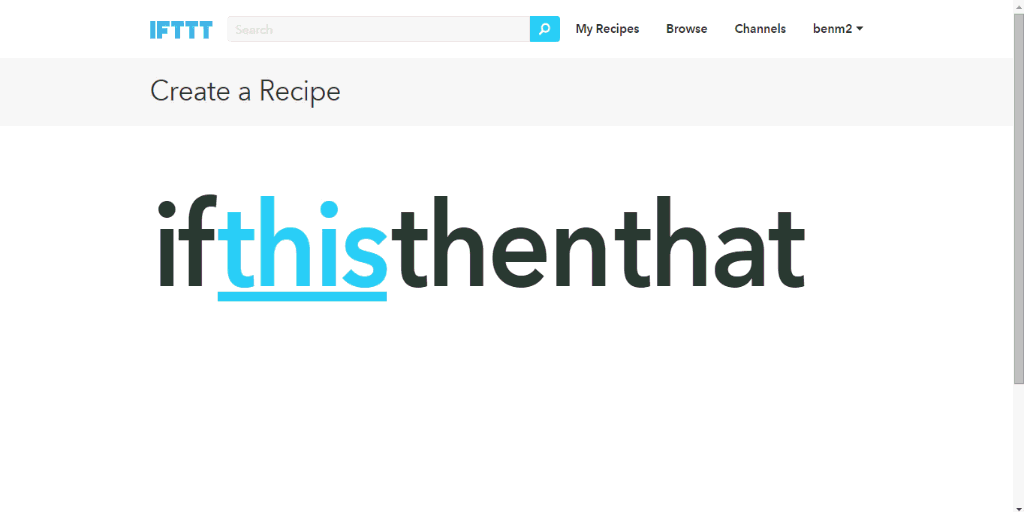
Another advantage that IFTTT has is that recipes are incredibly easy to obtain, as they are readily shared by their creators within the app itself; more often than not, if you’re looking to execute a specific process, or you’re just bum out of ideas, you’ll find something useful in their “Browse” section.
Zapier is also only available on a web browser, whilst IFTTT can be accessed on the web, through a desktop app (Windows, MAC or Linux) or even on mobile devices (iPhone and Andriod). This fits in nicely with IF’s ability to directly interact with a single app through “DO” recipes; you can utilize their app to save notes or receipts on the fly with Evernote, keep track of your work hours in Google Drive, or even ring your own phone to get out of an awkward situation.
In short, as far as the basics of the two apps go, Zapier allows greater customization and specialization with automating your processes, whilst IFTTT is easier to break into and more multi-purpose. The business tycoon vs the casual home user, if you will.
[ Download our Free Ebook ] – Click here to download our free 111 page ebook on “How to automate the tasks you hate at work using Zapier“.
Integrations
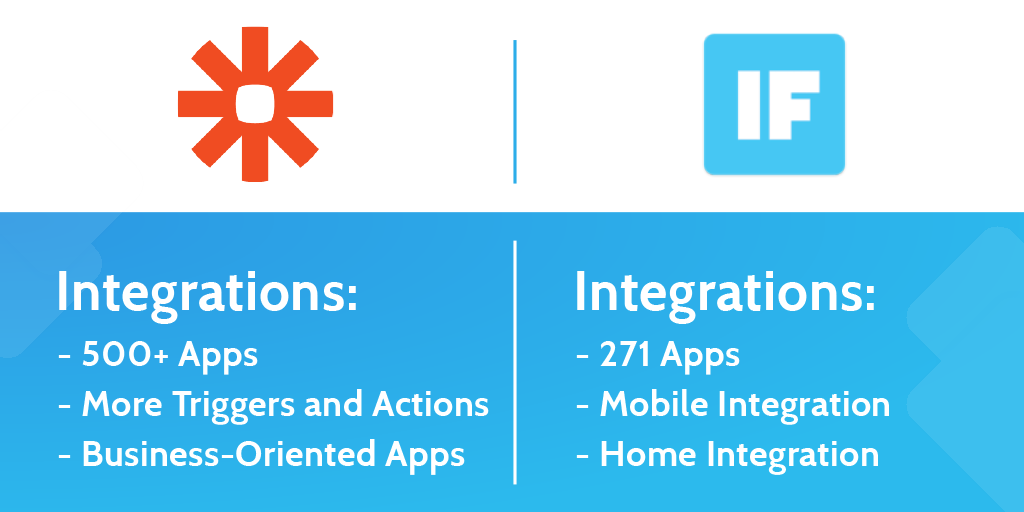
So, both of the apps we’re looking at have incredible similarities in their basic functions, albeit with Zapier sacrificing a little simplicity to have a greater usability. But what about their differences before a user has even come into the equation?
All workflow automation software needs to be able to integrate with the applications its users interact with. Notice the words we used there; if the software has integrations that its users are never going to take advantage of, they’re little better than a digital pet rock. To put it bluntly, numbers aren’t everything, as we also need to consider how these integrations can and will be used.
How Many and What Are They?
IFTTT currently sits at a cozy 271 integrations, whilst Zapier is showing off over 500. Both are linked up with your usual suspects, such as Buffer, Dropbox, Facebook, Gmail and Slack, but it isn’t just a case of Zapier having more.

One of the reasons why we earlier called IFTTT as more of the “casual” user’s application is that it can integrate with programs in your car and home. For example, you can remotely control your lights with Hue, open your garage door as you arrive home with Garageio or even set yourself a reminder if an engine light comes on!
This physical device interaction extends to your mobile, as there is an entire category of integrations which can carry out tasks based on your phone’s battery, current location, reminders or even texts.
Zapier, however, has the market cornered in terms of professional use, especially since multi-step zaps were introduced. Interactions with apps like Agile, Close, Google Analytics, Pipedrive and (of course) Process Street, along with the new multiple actions feature, allow you to collect data and use it, rather than set a mindless action with little to no flexibility.
As for organization, Zapier stores its integrations in one large search system, which can also be filtered by category (such as Customer Support or Lead Generation). Meanwhile, IFTTT once again gets down to basics by getting you to either type in the app you want to see, or scroll down a list of categories such as Business, Connected Car, Connected Home and Mobile.

For a full list of Zapier’s integrations, click here, and for IFTTT’s, click here.
How the Integrations Work
Even with a complete list of the integrated apps in front of you, you need to also consider how you’re going use them. After all, just because these apps are both linked to many of the same services does not mean that they can be used in the same ways.
For example, let’s take a look at Gmail, Dropbox and Slack, and what you can do with them on both Zapier and IFTTT. In Zapier, Gmail can be used to set 7 different triggers or 3 actions – IFTTT allows 6 triggers or just the 1 action. This isn’t too much of a disparity, and Dropbox follows this trend of Zapier being slightly more complex, with 2 triggers and 4 actions compared to 2 and 3. Slack, however, is where things get a little more telling.
Zapier integrates with Slack through a possible 5 triggers, 5 actions or 3 searches (mid-process information gathering steps). IFTTT has a grand total of 1 action for Slack and that’s it. Simplicity truly is the name of the game with If This Then That, which also translates into the accounts which you can link within the app.

Unlike Zapier, IFTTT does not allow you to link multiple accounts to your integrations (unless you want to make an entirely new account in order to do so). On the other hand, entire companies can synchronize their Twitter accounts through Zapier – there’s no limit.
Zapier Integration Example
To summarize, when looking at the integrations in the Zapier vs IFTTT battleground, neither app comes out with a decisive victory. Although I would lean more towards Zapier, owing to being a general data nerd, if you don’t quite need to analyze a twitter campaign or make your customer support run that bit smoother, IFTTT may be the better way to go. Integration-wise, it’s much easier to learn the ins-and-outs of, and get something simple set up like a WordPress automation. Plus, you can use it to control items around your home as an added bonus!
Workflow Options (Usage)
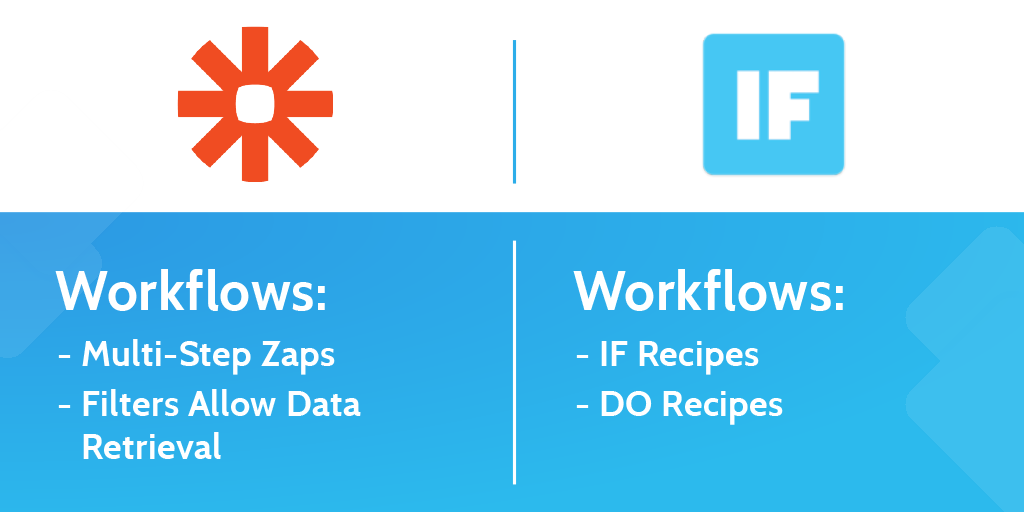
Next up in the criteria of Zapier vs IFTTT is the different ways in which these apps allow you to carry out your workflows. This is another field where, once again, we get the sense that Zapier is akin to the business version of IFTTT, if only due to the complexity of the actions you can carry out.
Multi-Steps vs DO Recipes
As we have seen in previous posts, one of Zapier’s greatest assets is its multi-step zap feature. By permitting you to attach as many actions to a single trigger as you desire, Zapier suits its user’s professional needs perfectly. This is mainly due to the incredible power of lookups in multi-step zaps; a manipulation which allows you to retrieve and utilize specific data within the same automatic process.
Whilst IFTTT does not allow for these complex workflows, it instead simplifies and streamlines the single-trigger-single-action process. In almost the complete opposite of Zapier’s fancy and potentially confusing multi-steps, IFTTT (on the surface) can even cut out the set trigger altogether and directly give you the ability to run a desired action through “DO” recipes.
Now, that may have been a bit of a mouthful, so allow me to explain. IFTTT’s standard “IF” recipes follow the same format as the basics of Zapier; one app triggers one action. However, the “DO” recipes allow the action to be triggered whenever you run the recipe – no trigger is required.
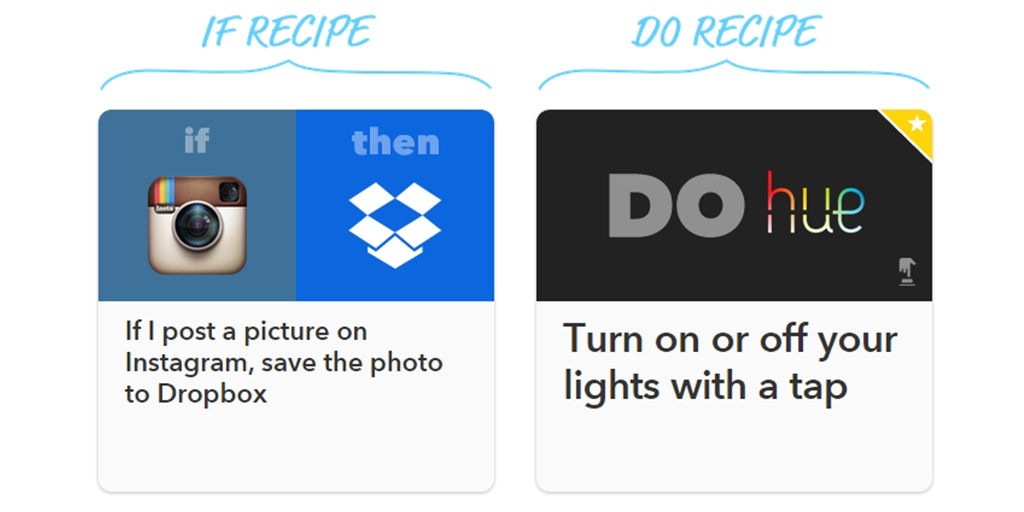
For example, one of the “DO” recipes is to create a note in Evernote. If you run the recipe, a new note will be created and saved, which you can then type straight into.
It is worth noting that this feature of IFTTT is especially potent when combined with the various platforms the app can be run on; booting up an app just to make a note in Evernote whilst on a computer is pointless, but using it whilst on a phone or iPad can be invaluable.
Filters
This is the first hurdle where we have a clear winner. Adding filters to your automatic workflows can make them insanely more powerful, at the expense of simplicity; you guessed it, Zapier is the only platform which allows this.
Although IFTTT is commendable in its efforts to stick to the basics and offer alternative ways to get around the ensuing issues (such as introducing separate DO apps for notes, photos, etc), Zapier’s filters can be used to truly focus down on the precise action and timescale you wish to apply.
Now, despite having gone over filters previously, let’s give you the run-down again. Filters can be placed before any action, limiting the zap to only running when preset criteria are reached. At their most basic, filters consist of a single command which draws data from either the trigger or a previous action; for example, “Only run this zap when the trigger email’s text contains the words ‘family photo'”.
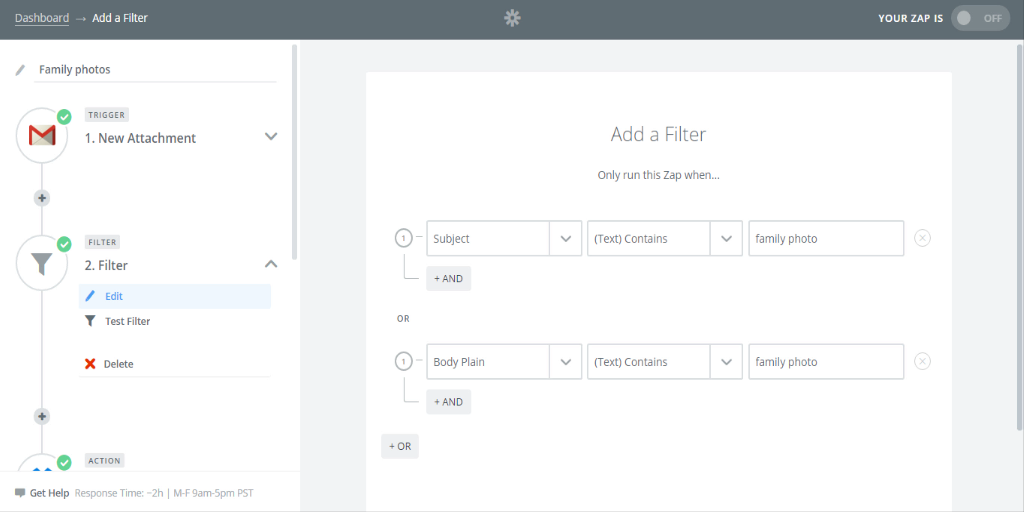
You don’t have to stop there, however, as you can set several lines of requirements, fitting into “And” or “Or” fields. “And” fields must all be met in order for the zap to fire, whilst “Or”s can be met instead of the other instructions. By using these variations, you can tailor all of your automatic processes, providing exceptions to your rules and preventing your complex zaps from firing due to (or causing) unwanted events.
Shared Recipes vs Zap Library
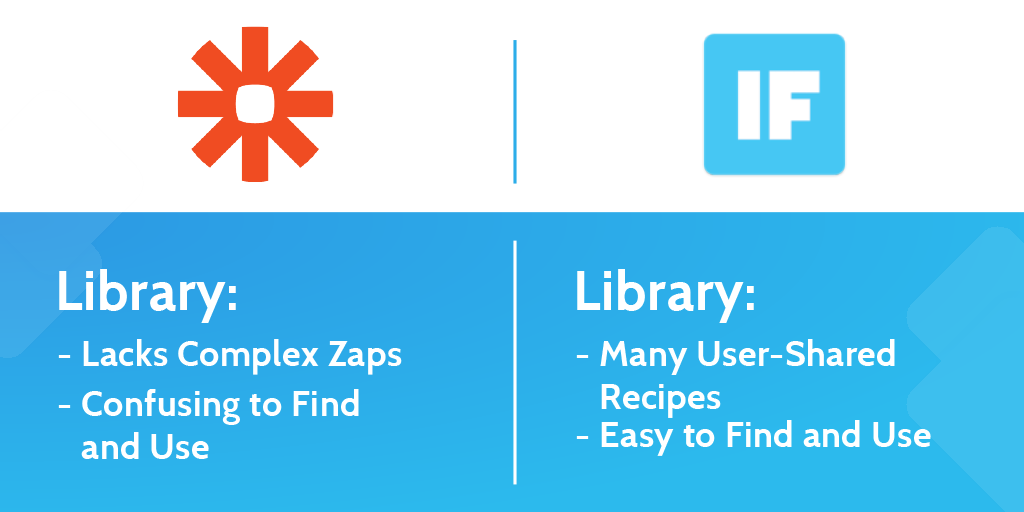
Let’s say that you want to use a certain process, but either don’t know how or don’t want to make it yourself; this is where the shared libraries of each app come in. Both zaps and recipes are provided for your convenience, ready to use from preset models, but which is the more useful library?
Starting with IFTTT, there’s almost no way to avoid the shared recipes (which is a good thing). Whether you load up the app version or just log into the site, the very first page you’re shown is the recipe page, which is split into 3 tabs; Recommended, DO Recipes and IF Recipes.
Honestly, I couldn’t fault this approach even if I wanted to. It beautifully plays into IFTTT’s ideal of simplicity, whilst giving you some stellar recipes and some data to boot (the creator’s username, how many users have the recipe, and how many have favorited it). Each entry comes with a customized title and description, detailing what exactly the recipe does.
All you need to do is scroll through to a recipe you like, click on it, connect your accounts and then click add. Beautiful.
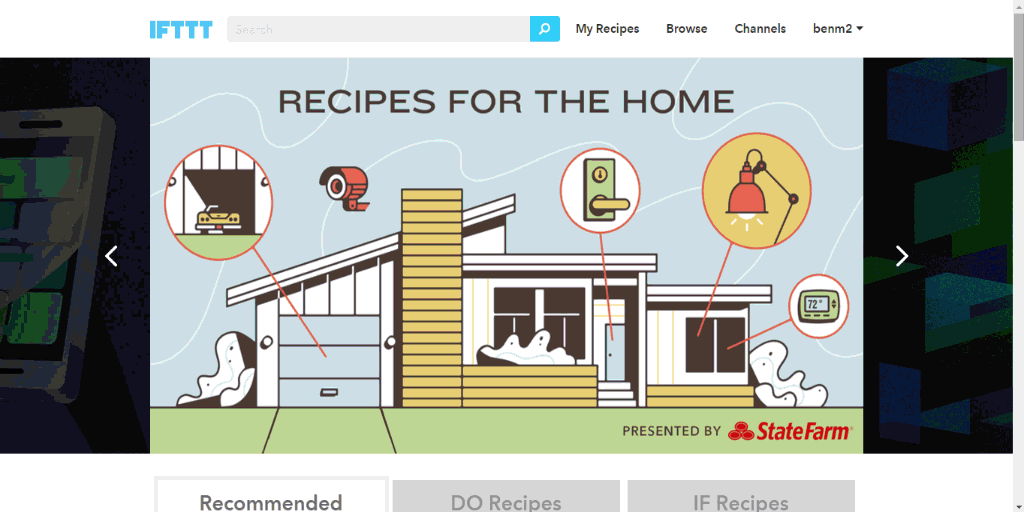
Zapier, on the other hand, trips up a little here. First up, viewing sample zaps isn’t quite as easy as shared recipes. Sure, it’s not exactly difficult, but for the user who just wishes to grab a premade zap and be off, logging in, moving to the Recommendations tab, selecting an app they want to use (through a slider) and then choosing from basic 2-step zaps isn’t ideal.
This is most definitely a category where Zapier’s complexity counts against it, and having multiple avenues and pages for the same basic premade zaps doesn’t particularly help. For perspective, you can also wind your way through the Explore or Use Cases tabs to find the very same zaps, albeit with slightly different categorization.
In fact, the presence of multiple pages with the same name, but different displays or functions confused me even whilst writing – the Use Cases page in the Zapbook (onsite tutorial / encyclopedia) serves the same function as the Use Cases tab within your dashboard, but has a completely different layout.
Due to the more complex nature of zaps, it’s understandable as to why there aren’t any premade examples (at least onsite) of powerful multi-step zaps ready to go, but this is definitely an area which could see some huge improvements.
Thankfully, we here at Process Street love a bit of a challenge. Zapier’s lack of detailed sample zaps was quickly combatted with a little creativity, research and trial and error, but the ease of access to useful recipes in IFTTT just can’t be ignored. At least for the casual user, IFTTT owns this segment.
User Experience
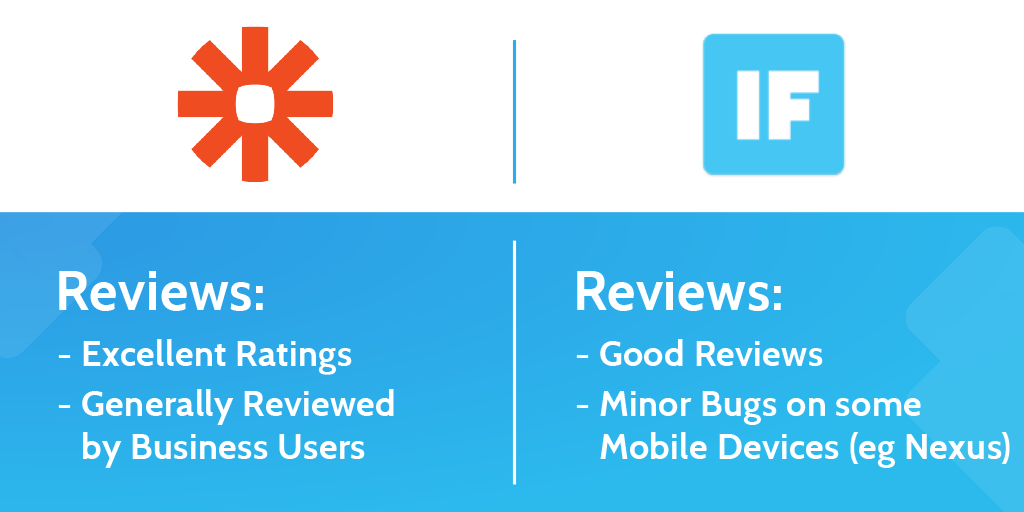
So far we’ve gone over the hard facts; what the basic features of each app are, what they integrate with – everything which can be quantified and safely determined to be fact between the two apps. Now it’s time to stray a little into the more ambiguous field of user experience, by comparing the reviews of each product. After all, what good is a single point of view when countless customers with countless setups have different experiences?
“Official” Reviews
Here we’ll be taking a look at the reviews of each product which have been made into articles; those with slightly more scholarly credentials, if you will.
‘One user created a recipe that will alert him via SMS if the CDC reports a zombie outbreak, while another user created one that automatically uploads any photo he posts to Facebook to Picasa, too. These two recipes sum up the appeal of IFTTT: it’s fun and pretty darn useful, too.’ – Liane Cassavoy
Across the board, IFTTT does impressively well. It’s true that some minor complaints crop up, such as broken initial downloads and no way to distinguish between an Android phone and tablet once both are connected to the same account. Largely, however, IFTTT is a hit in article reviews; the basic UI is going down nicely, along with the general ease of use once you have it up and running.
All in all, we’d say it’s a slam dunk.

‘If you run a small to mid-size business, you really ought to know about Zapier’ – Jill Duffey
Much like its competitor, Zapier also has stellar reviews; the potential of the platform, along with the sheer number of available integrations is often highlighted as a big enough selling point. Once again, however, we need to be a little careful, as the pricing plan (which we will cover later on) is brought into perspective when combined with the general affirmation that Zapier is a business automation tool.
What do I mean by that? Well, the vast majority of reviews state at one point or another that Zapier is good for business automation. Not only this, but those that do not often compare it to IFTTT, concluding that one cannot be recommended over the other. We’re seeing the business-casual divide between these apps in action; when treated as a business application Zapier will wipe the floor, but as a pure automation app, IFTTT manages to creep its way to level-heading.
User Reviews
There’s nothing like a trawl through the user review section of any product to give a little perspective. Users have a delightfully blunt way of tearing products apart, or breaking it in ways most others can’t even imagine, but a trawl through the reviews for these apps was pleasantly surprising.

IFTTT (including its mobile apps) once again garners general praised and high ratings, however, there do seem to be a series of odd bugs with certain devices. Nexus phones apparently don’t get on well with the apps, resulting in upside-down mirror images at best, straight out crashes at worst. DO Button struggles with Android shortcuts and certain uses of location triggers are hit-and-miss, but the apps combined are still hitting an average of 4/5 amongst the 80,000+ users who have left reviews.
Most likely because they’ve limited themselves to a single platform, Zapier has pretty much no the bugs amongst its users (that I could find). The only faults its (almost exclusively business-oriented) user reviews highlight is the complexity of the initial setup and the lack of useful premade zaps which we have already pointed out. Bear in mind that the reviews were much more limited in number, and so this could factor into the lack of technical issues reported.
In short, the user reviews pretty much mirror those in articles; from a casual standpoint IFTTT is the app to use (albeit with some minor issues on various platforms) whilst Zapier has the business market cornered.
Pricing Plans

Finally, let’s get down to the nitty-gritty topic of price in the comparison of Zapier vs IFTTT. Now, this may seem like a no-brainer, as only one of these apps actually has a paid model, but stick with us – there is method to the madness.
As you may have guessed by this point, IFTTT is a completely free model. No aspect can be enhanced by paying even if you wanted to (although there have been rumblings in the past about a paid model being introduced). This doesn’t mean that you’re getting a perfect service, however.
You can store and run your recipes for free with no worry, although to link multiple accounts to your integrated apps, you’ll need an entirely new account. Similarly (and probably due to being free), your recipes are limited in that they are not constantly or immediately executed – there can be a 15-minute delay for IF recipes to fire, or for the action of a DO recipe to save and transfer to the chosen app.
Meanwhile, Zapier stands true to its business focus and comes with several pricing plans, from completely free, up to $125 per month. As you would expect, the 5 plans off more features as they grow in price: 0$ per month allows you to save 5 zaps, leaves 15 minutes between trigger checks and allows 100 tasks per month, whilst $125 gives you 125 zap save slots, runs check every 5 minutes, allows 10,000 tasks per month, etc.
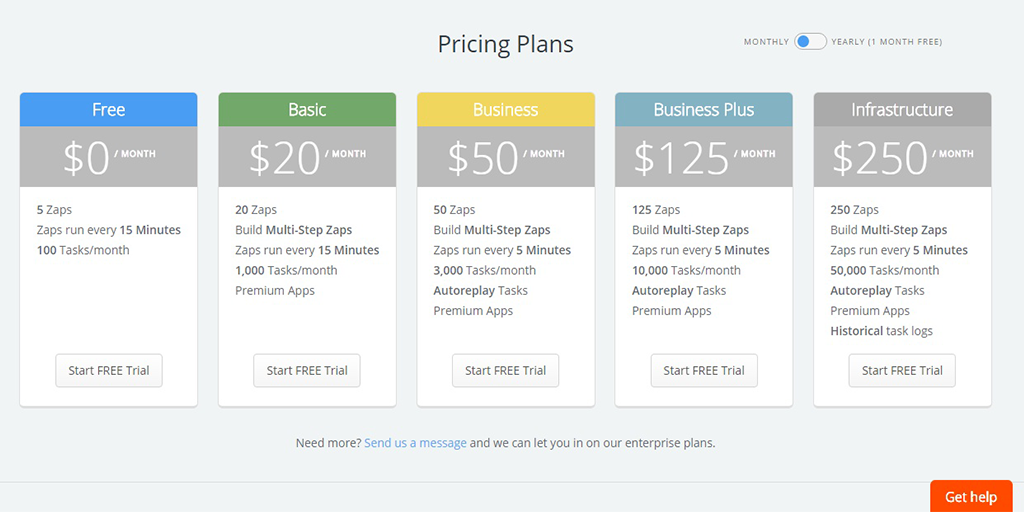
Now, it should be borne in mind that two very powerful features of Zapier are locked out from the free plan, these being multi-step zaps and certain “Premium” apps. If you want to take full advantage of Zapier’s usability over IFTTT, you’ll need to, at least, be using the $20 per month Basic plan. If you’re not certain about paying for Zapier, a 15-day free trial is available for their advanced features (such as multi-steps).
Using Zapier to its full potential is well worth the price tag, however, we’re once again returning to the question of business vs casual. If you just want a little automation for free, IFTTT has you covered with its lack of fees, whilst the more focused and dedicated automation user (who is willing to pay at least $20 per month) will find that they can get far more out of Zapier’s “Basic” plan.
Zapier vs IFTTT: The Finale

We’ve come full circle; the curtain is calling and we must put these apps to bed. After all of the examinations, which app should you be using to automate your life?
At the risk of being a cop out… We’d recommend both. Now, before the pitchforks come out, let us explain.
Zapier is an absolute monolith of automation software – if you need any level of complex task doing, Zapier can find the exact piece of data you’re after every single time and sort it all into your chosen location. There really is nothing that can contest it in this sense.
IFTTT, however, has the advantages of simplicity and mobility; the mobile apps allow you to fire quick recipes on the go or even adopt useful new ones from a truly fantastic selection of shared recipes. Need to make a note or save a receipt quickly and only have your phone? IF’s got you covered. Want to record your work or gym time, or perhaps set an important reminder? IF’s easy as pie to use.

There’s a reason that we’ve been trampling the business vs casual metaphor into the ground; if you want to get rid of as much of the tiresome legwork in your life as possible, use IFTTT in your personal life and Zapier for your business.
After all, who doesn’t love a bit of smart casual in their life?
If you think we missed any vital points, have any Zapier or IFTTT stories to share, or even just enjoyed the article then don’t forget to leave a comment. We reply to all of them and love speaking to you all!
Download our FREE 111 Page Ebook on Automation you Work with Zapier
Ever wished you could automate the stuff you hate doing at work? Then you need to check out The Ultimate Guide To Business Process Automation with Zapier!
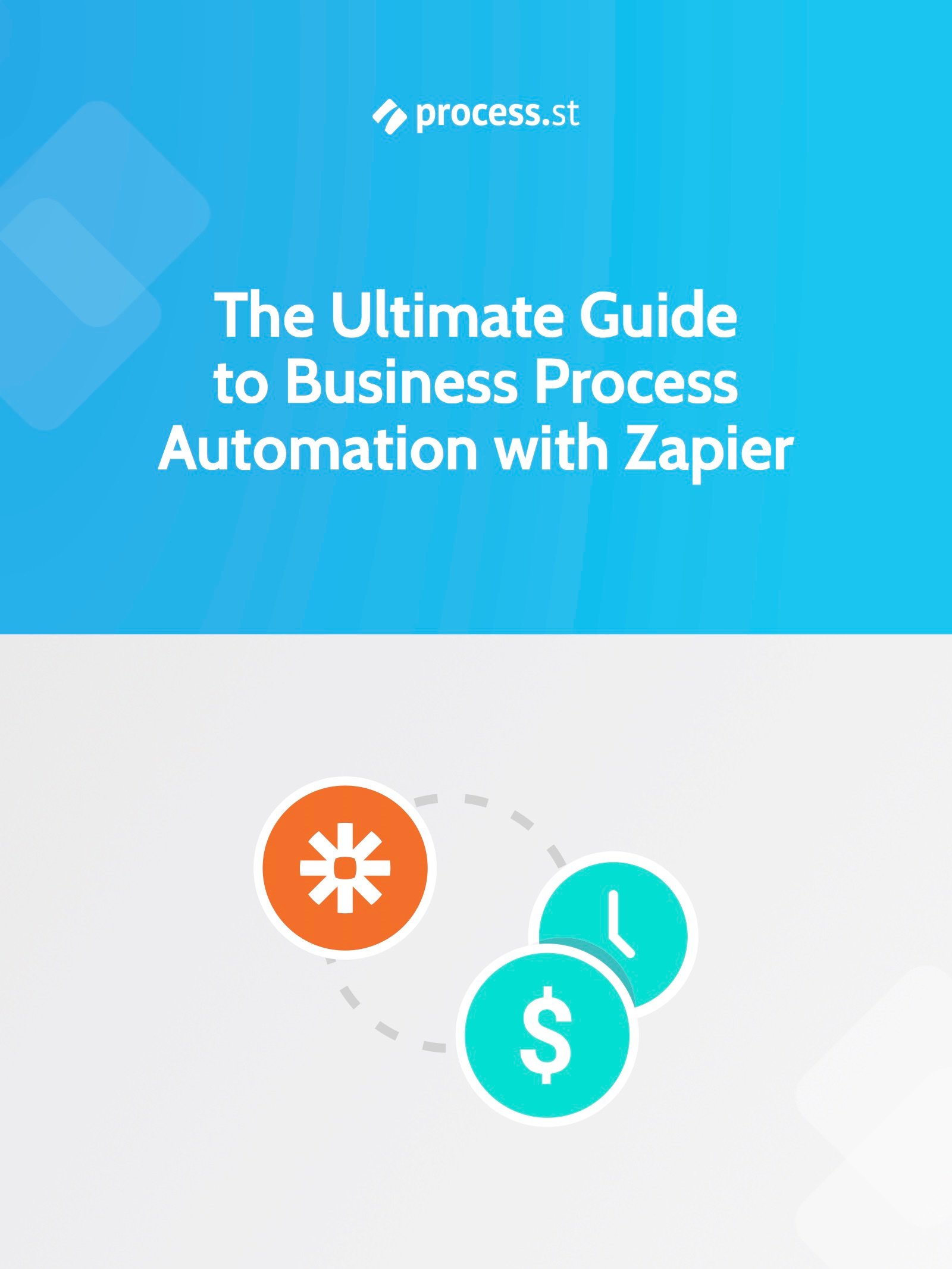
We’ve created the perfect resource to get you saving time and money by automating your business’ processes.
From basic tasks such as saving Gmail attachments into Dropbox to shipping your Salesforce leads into Mailchimp, the Ultimate Guide will guide you through setting up the perfect Zaps to automatically handle the tasks that clog up your schedule.
Plus, with Zapier’s 500+ integrated apps, chances are that your favorite programs are just waiting to be linked!
Better yet, it’s completely free!

What’s in the Ebook?
- What is Zapier – A Brief Introduction to Business Automation
- The Real Power of Zapier – Lookups, Filters and Multi-Step Zaps
- Zapier vs IFTTT: The Best Way to Automate Your Life?
- 222 Zaps You Can Start Using Right Now
- 50 Examples of Business Process Automation from the World’s Most innovative Companies
- 50 more Examples of Workflow Automation using Process Street







 Workflows
Workflows Projects
Projects Data Sets
Data Sets Forms
Forms Pages
Pages Automations
Automations Analytics
Analytics Apps
Apps Integrations
Integrations
 Property management
Property management
 Human resources
Human resources
 Customer management
Customer management
 Information technology
Information technology



Ben Mulholland
Ben Mulholland is an Editor at Process Street, and winds down with a casual article or two on Mulholland Writing. Find him on Twitter here.